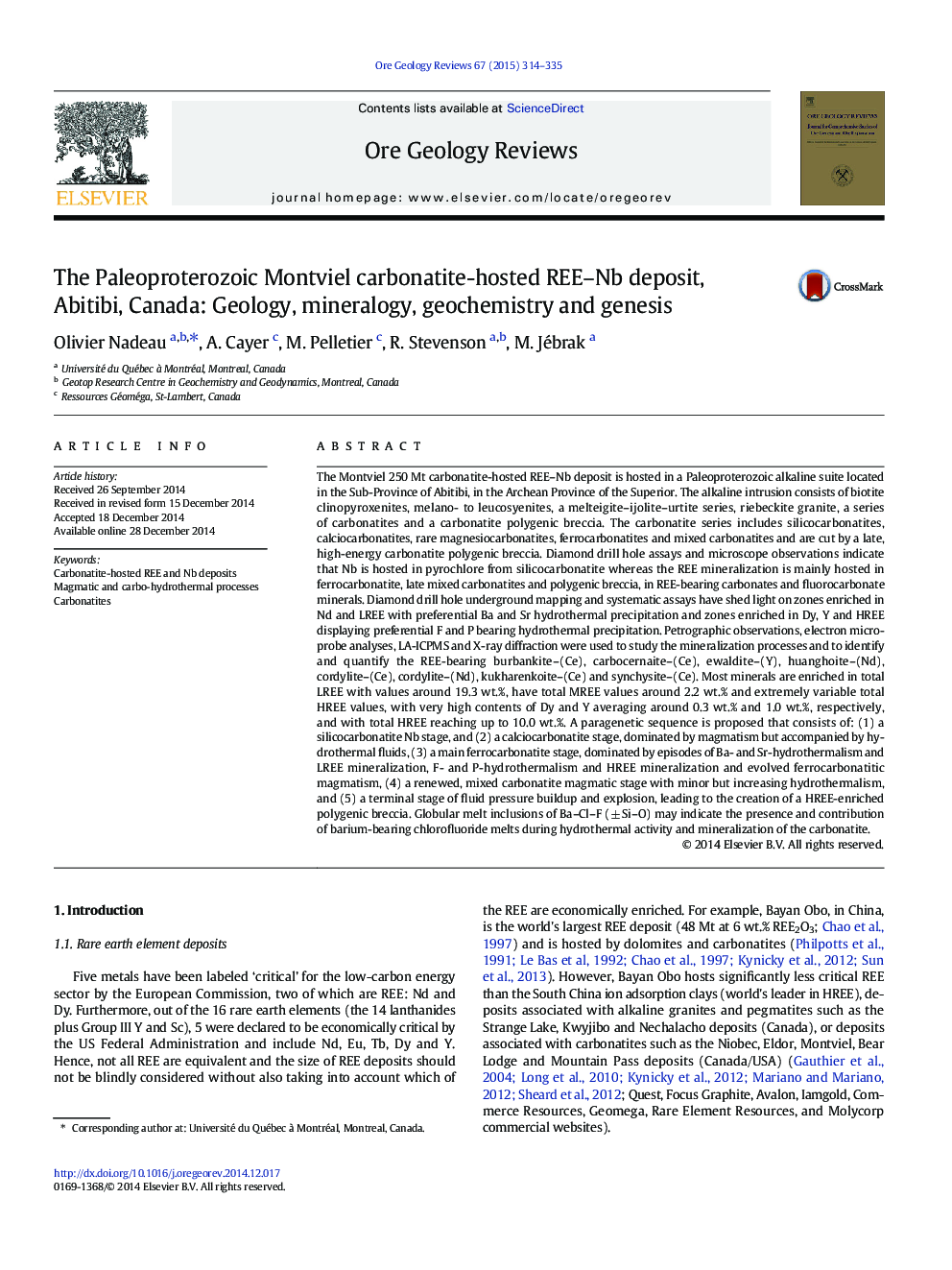| Article ID | Journal | Published Year | Pages | File Type |
|---|---|---|---|---|
| 6435896 | Ore Geology Reviews | 2015 | 22 Pages |
â¢Field relations and sub-surface mapping are reported for the first time at this carbonatite-hosted REE-Nb deposit.â¢Selected drill hole assays show good correlation of LREE with Ba and Sr alterations, and HREE with P and F alterations.â¢X-ray diffraction, electron microprobe and scanning electron microscope work illustrate and identify REE carbonates and fluorocarbonates.â¢Laser ablation ICP-MS was used to quantify REE concentrations in these REE-bearing carbonates and fluorocarbonates.â¢Mysterious Ba-Cl-F ± Si-O melt inclusions were discovered and relate to fluorite-hosted inclusions in Bayan Obo carbonatite.
The Montviel 250 Mt carbonatite-hosted REE-Nb deposit is hosted in a Paleoproterozoic alkaline suite located in the Sub-Province of Abitibi, in the Archean Province of the Superior. The alkaline intrusion consists of biotite clinopyroxenites, melano- to leucosyenites, a melteigite-ijolite-urtite series, riebeckite granite, a series of carbonatites and a carbonatite polygenic breccia. The carbonatite series includes silicocarbonatites, calciocarbonatites, rare magnesiocarbonatites, ferrocarbonatites and mixed carbonatites and are cut by a late, high-energy carbonatite polygenic breccia. Diamond drill hole assays and microscope observations indicate that Nb is hosted in pyrochlore from silicocarbonatite whereas the REE mineralization is mainly hosted in ferrocarbonatite, late mixed carbonatites and polygenic breccia, in REE-bearing carbonates and fluorocarbonate minerals. Diamond drill hole underground mapping and systematic assays have shed light on zones enriched in Nd and LREE with preferential Ba and Sr hydrothermal precipitation and zones enriched in Dy, Y and HREE displaying preferential F and P bearing hydrothermal precipitation. Petrographic observations, electron microprobe analyses, LA-ICPMS and X-ray diffraction were used to study the mineralization processes and to identify and quantify the REE-bearing burbankite-(Ce), carbocernaite-(Ce), ewaldite-(Y), huanghoite-(Nd), cordylite-(Ce), cordylite-(Nd), kukharenkoite-(Ce) and synchysite-(Ce). Most minerals are enriched in total LREE with values around 19.3 wt.%, have total MREE values around 2.2 wt.% and extremely variable total HREE values, with very high contents of Dy and Y averaging around 0.3 wt.% and 1.0 wt.%, respectively, and with total HREE reaching up to 10.0 wt.%. A paragenetic sequence is proposed that consists of: (1) a silicocarbonatite Nb stage, and (2) a calciocarbonatite stage, dominated by magmatism but accompanied by hydrothermal fluids, (3) a main ferrocarbonatite stage, dominated by episodes of Ba- and Sr-hydrothermalism and LREE mineralization, F- and P-hydrothermalism and HREE mineralization and evolved ferrocarbonatitic magmatism, (4) a renewed, mixed carbonatite magmatic stage with minor but increasing hydrothermalism, and (5) a terminal stage of fluid pressure buildup and explosion, leading to the creation of a HREE-enriched polygenic breccia. Globular melt inclusions of Ba-Cl-F (± Si-O) may indicate the presence and contribution of barium-bearing chlorofluoride melts during hydrothermal activity and mineralization of the carbonatite.
